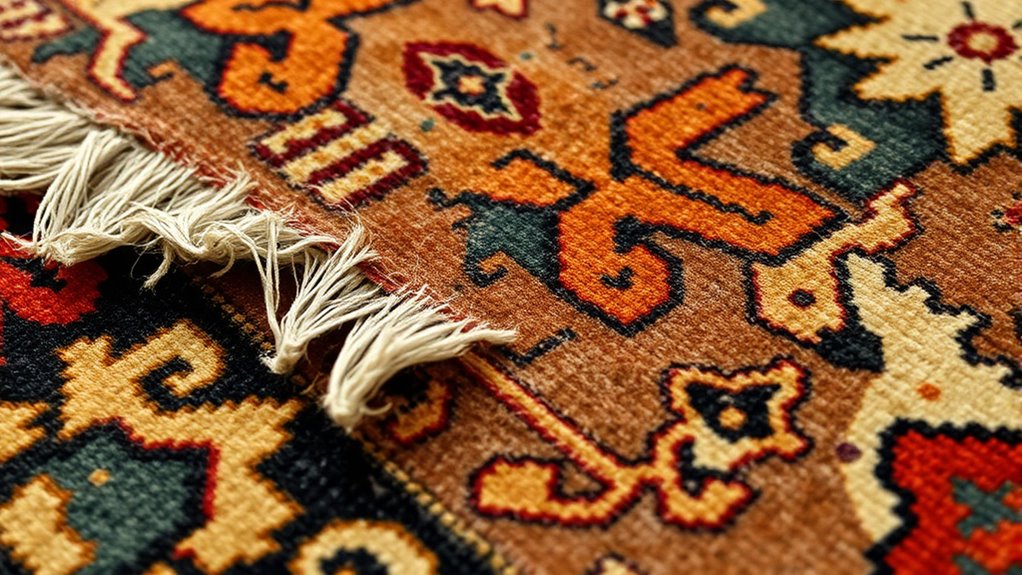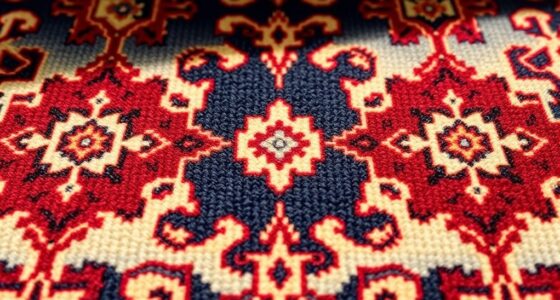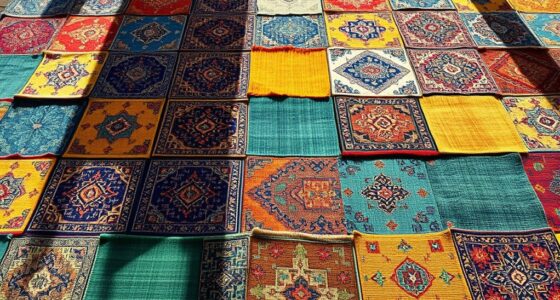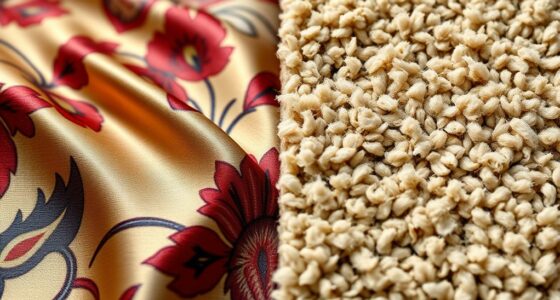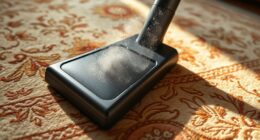When evaluating antique rugs, you should look for genuine patina, which appears as a subtle, even glow with soft color shifts and a smooth texture that deepens with age. Damage, on the other hand, often shows as irregular tears, frayed edges, or stiff spots that stand out from the surface. By observing color fading, texture changes, and wear patterns, you can tell apart authentic aging from damage. Keep exploring to understand how these signs reveal a rug’s true history.
Key Takeaways
- Genuine patina appears as a soft, even glow with subtle color shifts; damage often shows irregular, sharp edges or tears.
- Patina develops uniformly over time, while damage causes uneven discoloration and irregular texture or fiber loss.
- Authentic wear features gentle fading and smooth surface changes; damage may result in brittle, stiff, or rough areas.
- Patina blends seamlessly with the rug’s surface; damage tends to stand out due to contrast, irregularity, or over-restoration.
- Texture differences, such as softness and elasticity, help distinguish natural aging from areas of repair or deterioration.
Understanding the Concept of Patina in Antique Rugs
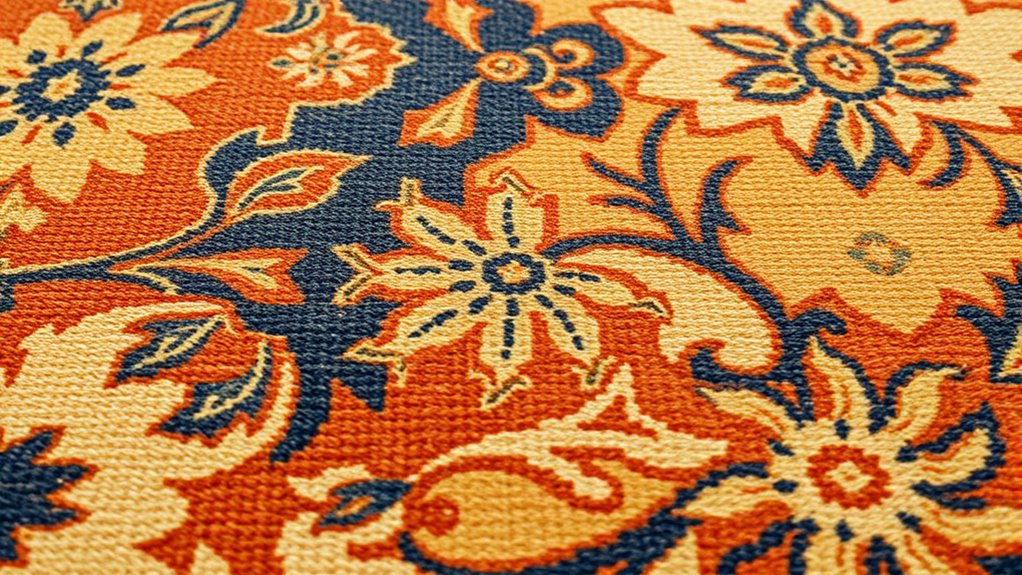
Understanding patina in antique rugs is essential because it reflects the rug’s history and adds to its character. Patina develops over time, influenced by factors like fiber composition and exposure to light and air. The type of fibers used, such as wool, silk, or cotton, affects how the rug ages and how the patina forms. Wool, for example, tends to develop a soft sheen, while silk can gain a rich luster. Dye stability also plays a fundamental role; dyes that resist fading contribute to a more authentic patina, showing subtle color changes rather than stark deterioration. Recognizing these elements helps you appreciate the rug’s age and authenticity, distinguishing genuine patina from superficial wear or damage. Additionally, understanding the aging process of different fibers can provide deeper insight into a rug’s overall condition and value, as well as how environmental factors impact fiber deterioration. Being aware of the environmental influences that affect antique rugs can help in better preservation and care practices.
Recognizing Signs of Genuine Patina

When examining an antique rug, spotting genuine patina involves more than just noticing surface wear. True patina develops naturally over time, creating a subtle, even sheen that enhances the rug’s character. Be cautious if you see signs of modern cleaning, like overly bright or uniform areas, which can mask authentic aging. Similarly, dye restoration often leaves behind uneven or overly vibrant patches that don’t match the original dye palette. Genuine patina usually exhibits gentle fading and a soft luster that’s consistent across the rug. Feel for a smooth, aged texture rather than a stiff or newly restored surface. Recognizing these signs helps ensure you’re appreciating the rug’s authentic history, not a surface altered by artificial processes. Additionally, understanding angel numbers can help deepen your appreciation of the rug’s spiritual and cultural significance, connecting you to its true origins. Proper knowledge of authentic aging processes can further assist in distinguishing genuine patina from artificial enhancements. Being aware of AI security vulnerabilities can also inform you about the importance of protecting these valuable artifacts from digital threats. Gaining insight into vibrational energy can enhance your ability to connect with the rug’s historical and spiritual essence. Moreover, understanding the materials used in traditional rug-making can provide more context for recognizing genuine aging signs.
Common Types of Damage in Antique Textiles
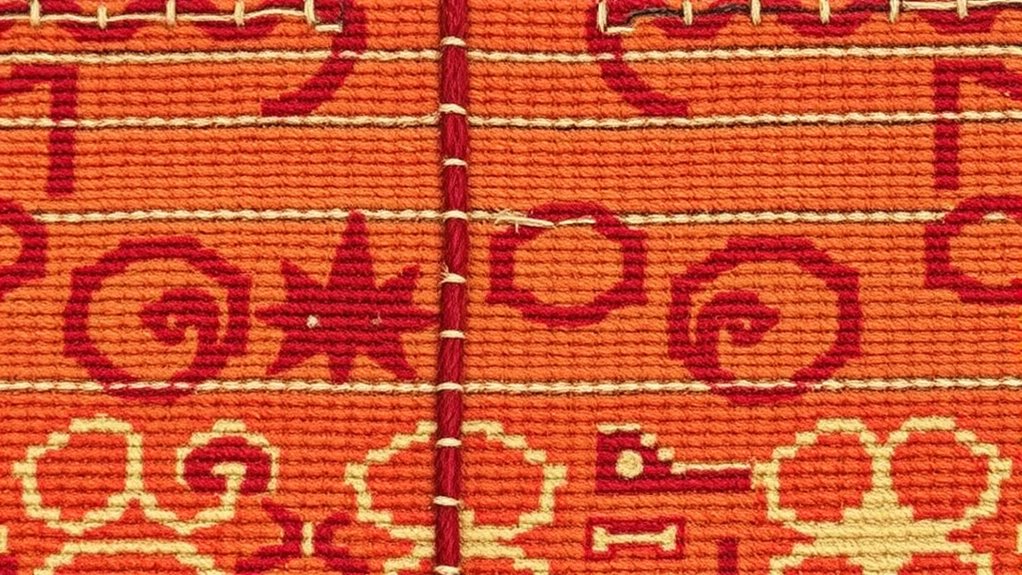
Antique textiles often bear the marks of their long history, with damage manifesting in various forms that can affect their value and appearance. Common issues include fringe fraying, where the threads at the edges become worn or unravel, and knot looseness, which weakens the rug’s structure. Fringe fraying may look like uneven or frayed edges, indicating age or rough handling. Knot looseness occurs when the original knots start to unravel, leading to areas that feel less dense or appear uneven. These damages are typical in well-used textiles and can sometimes be mistaken for patina, but they reveal the textile’s wear and age. Recognizing these signs helps you distinguish between genuine wear and potential damage, guiding proper preservation and valuation. Additionally, understanding the significance of cultural impact can aid collectors in assessing the historical value of antique rugs. Proper maintenance and understanding of textile conservation techniques are essential to prolong the lifespan of these delicate artifacts.
Visual Cues to Differentiate Between Patina and Damage
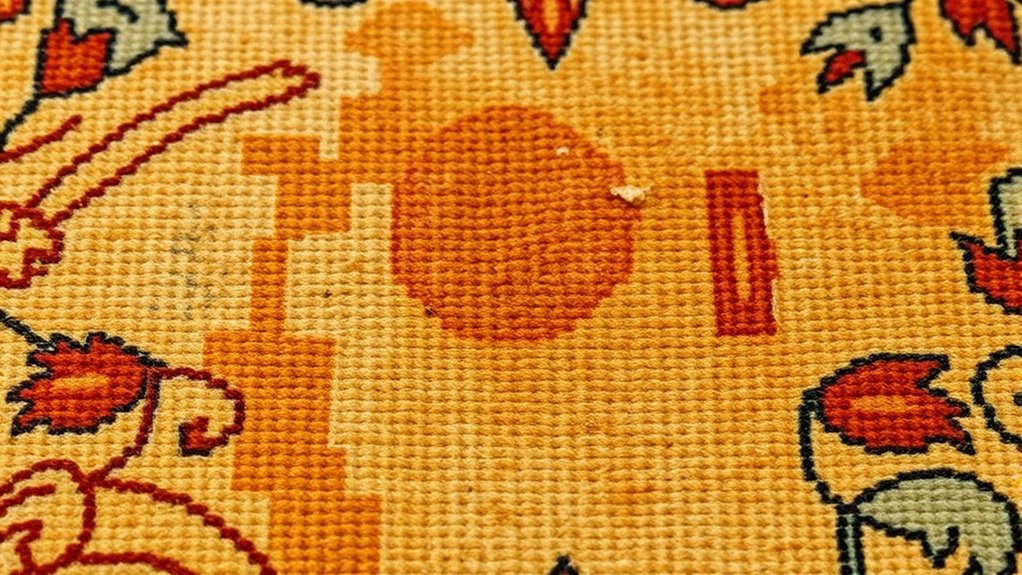
Distinguishing between patina and damage relies heavily on visual cues that reveal their different origins. Patina typically appears as a soft, even glow that deepens the rug’s color and shows signs of age, such as subtle fabric deterioration. Damage, on the other hand, often features irregular, sharp-edged areas with inconsistent wear or tears. Restoration marks can also help identify damage; they might be visible as patches, over-stitched areas, or differences in fiber texture. Patina generally blends seamlessly into the rug’s surface, maintaining uniformity, while damage tends to stand out due to its irregularity and contrast. By closely examining these cues, you can better assess whether wear reflects authentic aging or recent repair and damage. Understanding holistic approaches to rug care can also aid in preserving the appearance of patina while preventing further deterioration. Incorporating proper maintenance techniques can help sustain the rug’s character and structural integrity over time, and recognizing authentic signs of age is crucial for accurate evaluation. Additionally, paying attention to natural wear patterns can provide further insight into the rug’s true age and history. Recognizing sustainable preservation methods can also support ongoing care efforts.
The Role of Color and Texture in Evaluation
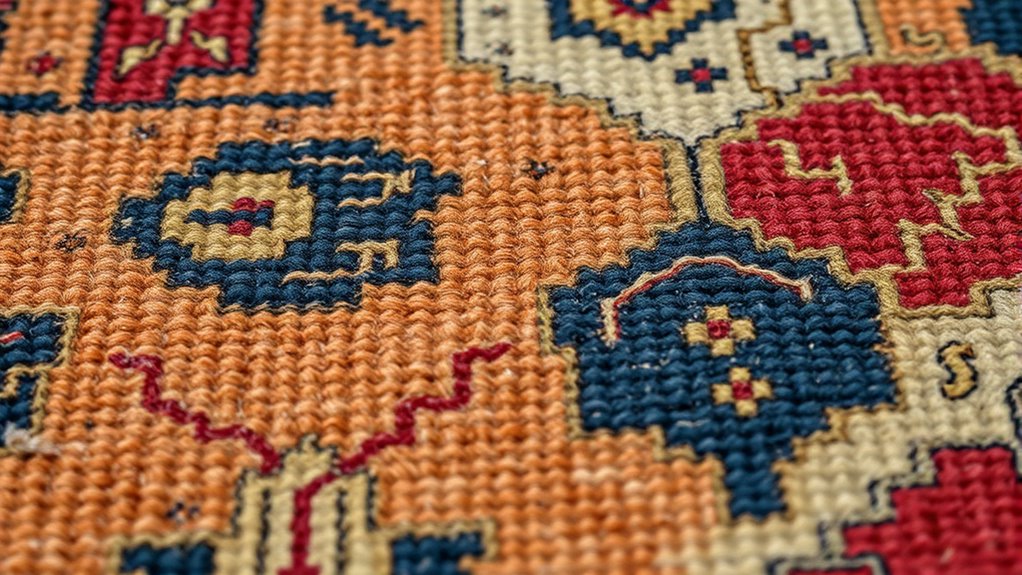
You should pay close attention to color fading, as genuine patina often has a uniform, soft look, while damage may cause uneven discoloration. Texture changes can reveal authenticity, with patina typically blending smoothly into the rug’s surface, unlike rough or irregular areas caused by wear or tears. Recognizing these subtle differences helps you accurately assess whether color and texture indicate age or damage. Additionally, understanding the aesthetic appeal of antique rugs can offer insights into the value and preservation of antique items. Paying attention to the wear patterns can also provide clues about the rug’s history and usage over time.
Color Fading Indicators
Color fading is a key indicator when evaluating the condition of antique rugs, as it reveals how exposure to light and environmental factors have impacted the original vibrancy. Look closely at fading patterns—irregular or uneven areas often suggest natural aging, while uniform fading might indicate prolonged exposure to sunlight. Dye degradation, caused by chemical breakdown over time, results in subtle shifts or loss of color intensity. Pay attention to areas where colors have softened or shifted, as these signs can point to the rug’s history of wear. Consistent fading across the rug usually signifies age, while inconsistent patches may indicate damage or repair. By understanding these color changes, you can better assess whether fading is a natural patina or a sign of deterioration.
Texture Changes Significance
Texture changes in antique rugs often reveal more than just surface wear; they can provide insight into the rug’s history and condition. When fibers lose elasticity over time, the rug feels flatter or more brittle, indicating age and use. Texture variations also reflect dye stability; areas with stable dyes maintain their original texture, while faded or damaged sections may feel different due to fiber degradation. Noticing these subtle shifts helps you distinguish between genuine wear and damage. A rug with consistent fiber elasticity and stable dyes typically indicates well-preserved patina, whereas uneven textures might suggest repairs or deterioration. By paying attention to texture changes, you gain a deeper understanding of the rug’s provenance and current state, guiding your appraisal with confidence.
Assessing the Rug’s Age and Historical Context

You can estimate a rug’s age by examining how its patterns have changed over time, revealing design trends and craftsmanship shifts. Look for historical significance indicators, like regional motifs or unique weaving techniques, to help place its origins. Understanding these clues provides valuable context for authenticating and valuing your antique rug.
Pattern Evolution Over Time
As a rug ages, its patterns often undergo subtle shifts that reveal much about its historical origin. You might notice fading patterns where colors lose vibrancy, hinting at prolonged exposure to light or wear. Dye migration can cause colors to bleed into one another, creating a softer, more blended look over time. These changes help you gauge the rug’s age and craftsmanship.
- Fading patterns indicate prolonged use or aging.
- Dye migration shows natural dye characteristics and age.
- Slight pattern distortions suggest handwoven techniques.
- Color variations reflect regional dyeing traditions.
- Wear on specific motifs points to common foot traffic areas.
Understanding these evolutions helps you appreciate the rug’s history, making it more than just an object—it’s a story woven into its fabric.
Historical Significance Indicators
Identifying the age and historical context of an antique rug involves examining specific indicators that reveal its origin and period. Look closely at weaving techniques, as older rugs often feature hand-spun yarns and traditional knotting styles. Dye stability also provides clues; natural dyes tend to fade and develop a patina over time, unlike synthetic dyes that remain vivid.
| Indicator | What to Observe | Significance |
|---|---|---|
| Weaving Techniques | Hand-spun yarns, knot styles | Dating the rug’s period |
| Dye Stability | Fading, color variation | Authenticity and age |
| Design Evolution | Patterns reflecting historical trends | Cultural context and origin |
Tips for Preservation and Care of Antique Rugs
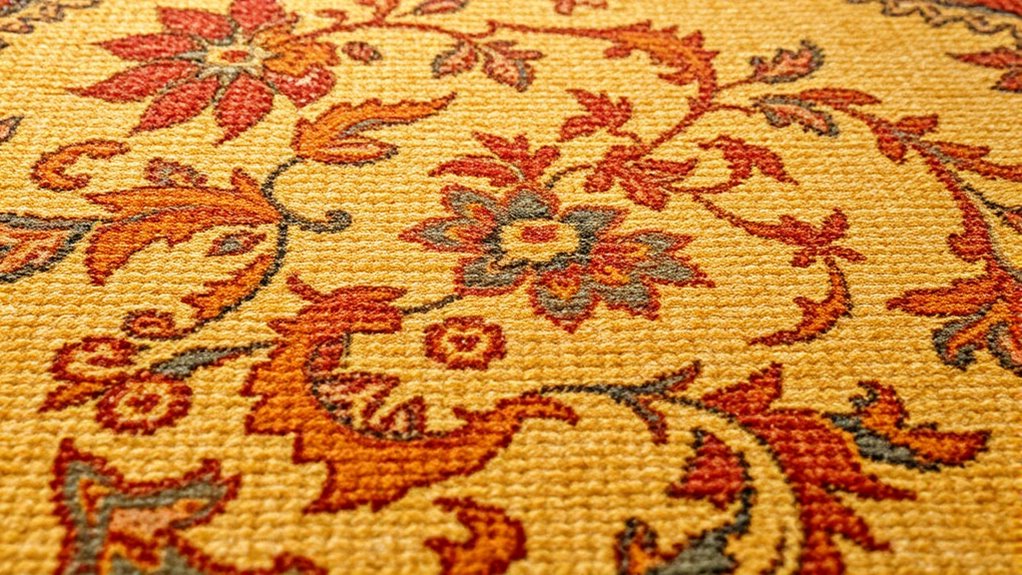
Proper preservation and care are essential to maintain the beauty and value of antique rugs. To do this, handle your rug gently, avoiding excessive cleaning or harsh chemicals. Protect the fringe preservation, as frayed edges can weaken the rug’s structure; regular, gentle cleaning helps maintain it. Be mindful of knot density when inspecting your rug, since higher knot density indicates durability and quality. Rotate your rug periodically to prevent uneven wear and fading. Keep it away from direct sunlight and moisture, which can cause deterioration. Use appropriate padding underneath to reduce friction and stress on the fibers. Ultimately, consult a professional for regular inspections and repairs, ensuring your antique rug stays in excellent condition for years to come.
Frequently Asked Questions
How Can I Determine the Origin of an Antique Rug’s Patina?
To determine the origin of your antique rug’s patina, start by examining its dye source and weaving techniques. Natural dyes from regions like Persia or India often produce unique color shifts over time, creating a distinctive patina. Also, look at the weaving style, as specific techniques point to certain areas. Combining these clues helps you identify where your rug’s patina originates, revealing its cultural and historical background.
What Tools or Magnification Techniques Assist in Identifying Damage?
To identify damage on an antique rug, you can use microscopic inspection to closely examine fibers and weave for signs of wear, repairs, or deterioration. UV light analysis is also helpful, as it reveals repairs or alterations not visible to the naked eye. These tools allow you to distinguish genuine wear from damage, helping you assess the rug’s condition and authenticity more accurately.
Can Repairs or Restorations Affect the Appearance of Patina?
Imagine your antique rug’s story being subtly rewritten; repairs or restorations can influence its charm by causing a gentle patina alteration. While restoration impact may seem minor, it can sometimes diminish the rug’s original character or authenticity. You should consider how these changes might affect its value and appearance, ensuring any restoration respects the rug’s history. A careful approach helps preserve its timeless beauty and essence.
How Does Environmental Exposure Influence Rug Wear Over Time?
Environmental factors like sunlight, humidity, and foot traffic markedly influence rug wear over time. You’ll notice natural aging as fibers gradually weaken and colors fade due to constant exposure. Sunlight can cause fading, while high humidity might lead to mold or mildew. To preserve your rug’s beauty, keep it out of direct sunlight, control indoor humidity, and minimize heavy foot traffic. These steps help maintain its condition and prolong its lifespan.
Are There Specific Signals That Indicate Intentional Aging or Artificial Aging?
When you evaluate signs of intentional aging on antique rugs, look for subtle clues like uneven color variations, which suggest chemical treatments, and inconsistent surface abrasion, indicating artificial wear. These signals often differ from natural aging patterns, helping you distinguish genuine patina from manipulated effects. You notice the deliberate effort behind these signs, guiding you to better assess the rug’s authenticity and historical value.
Conclusion
By mastering the art of distinguishing patina from damage, you hold the power to discover the true story of each antique rug. With your keen eye, you’ll prevent costly mistakes and preserve centuries of craftsmanship. Imagine revealing secrets buried beneath layers of time—your expertise could save these treasures from oblivion! Don’t just admire—become a guardian of history, ensuring these mesmerizing textiles enchant generations to come. Your passion can make history stand the test of time!
